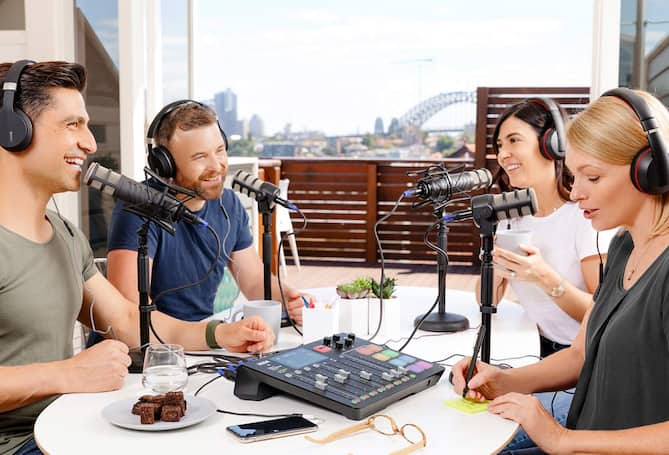11 Essential Items for Podcasting

Must-have gear to grow your audience.
If you’re not already familiar with the podcasting world, you may wonder what a podcast is and why they are becoming so popular. A podcast is an audio series recorded in episodes that listeners can download and enjoy at their convenience. For a podcast to be successful, it needs to have engaging topics that keep listeners coming back for more. If you have captivating stories and opinions to share, the next question to ask is: what do you need to start a podcast?
Besides a good idea, an excellent point of view and a popular platform, you’ll need the right equipment to start your own podcast. This includes the recording equipment required to capture conversations between you and your guests and specialized computer software used to edit recorded clips. The type and style of your podcast will determine the best podcasting equipment for you. If you’re serious about starting a podcast, here are eleven essential pieces of equipment you'll need for a successful venture.
1. Computer.
2. Microphones.
Microphones are the most important piece of audio equipment for podcasting. A dedicated microphone is a better audio capture tool than your computer’s built-in microphone. When looking for the best podcasting equipment in this category, you’ll have to decide between USB and XLR mics that use either condenser or dynamic technology. A USB mic plugs directly into a computer and is a good audio capture tool for a beginner. An XLR mic provides more flexibility and better control of audio quality and level. Keep in mind that an XLR mic plugs into an audio interface, mixer or digital recorder and unlike a USB mic, it requires an external power source.
Dynamic mics are less sensitive to ambient noise and are better for recording multiple people in the same room. Condenser mics are more sensitive and produce crisper sounds. Use the latter type if you have a podcast studio with acoustic treatment that can help reduce echo and ambient noise.
3. Pop filters and windscreens.
4. Microphone stands.
5. Audio interface.
6. Mixer.
7. Headphones.
8. Headphone amplifier.
9. Portable digital recorder.
10. Podcast recording and editing software.
Along with recording equipment and a computer, editing software is a must have. Using podcast recording software results in high-quality audio from microphones and other audio sources. Besides capturing audio, you also need digital audio workstation (DAW) software to edit various clips into podcast episodes. Plus, you can add sound effects and soundtracks, correct pitch and harmonize sound levels from different sources with a DAW. When choosing podcast recording and editing software, remember to select one that’s compatible with your computer’s operating system.
Even if you're just starting out, you may wonder how do podcasts make money? Profitable podcasts run ads and rely on sponsorship deals. Some advertisers might also direct listeners to their merchandise stores. When you’re ready to monetize your podcast, you’ll need to know how to use recording and editing software to splice ads and insert sponsors’ messages into your episodes.
11. Acoustical treatments.
Acoustical treatments involve the use of soundproofing materials to eliminate echoes and reverbs in the space you’ll use for recording your podcast. Soundproofing your podcasting studio with foam tiles and carpeting will make a huge difference in sound quality. Therefore, it should be a key consideration when drawing up a list of essentials. Depending on the extent of reverb and ambient noise, you may need to install acoustic panels on both the walls and the ceiling of your space.
For many aspiring to start a podcast as a money-making venture, they might wonder how much do podcasters make? However, to create a popular and lasting podcast, first focus on finding a topic you’re passionate about and acquire the equipment needed to produce a high-quality podcast. Once you have all the essential podcasting tools you’ll need, you’ll be ready to turn your views and stories into a podcast worth listening to. The more passionate and prepared you are, the better chances you’ll have at gaining traction financially.